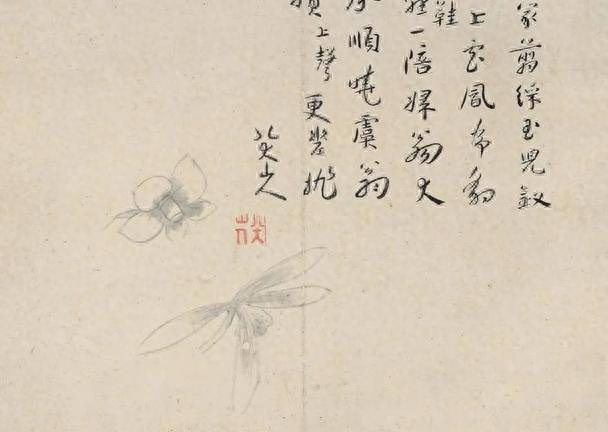
Zhu Da orchid
Bada Shanren was originally a grandson of a Ming Dynasty prince. After the fall of the Ming Dynasty, his country was destroyed and his family was destroyed. He felt sad and angry, and became a monk. He considered himself a survivor of the Ming Dynasty and refused to cooperate with the Qing court. His works often use symbolic techniques to express his feelings, and his pen and ink are characterized by laissez-faire, vigorous, round, graceful and elegant, which have a great influence on later generations.
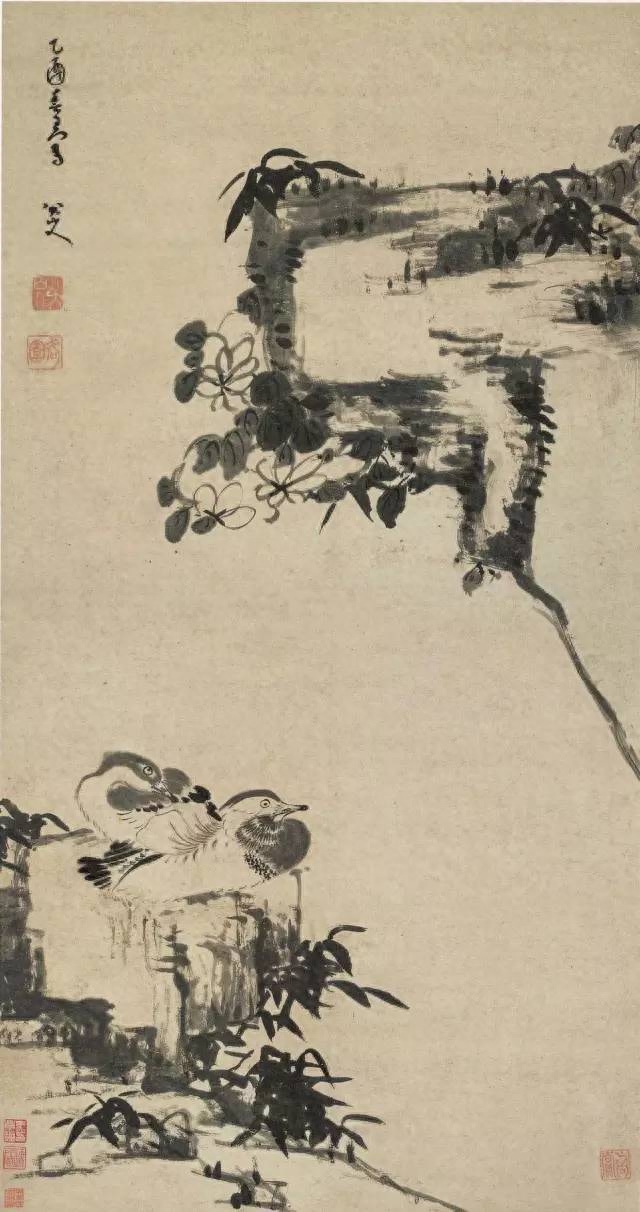
Qing Dynasty Bada Shanren Bamboo and Stone Mandarin Duck
Bada Shanren is not a simple calligrapher, but an artist who is good at calligraphy and painting. His paintings have a greater impact on later generations. Only a few people (such as Huang Binhong) realize that Bada Shanren's calligraphy is superior to his paintings. From the perspective of calligraphy history, Bada Shanren's calligraphy is an outstanding representative of painters' calligraphy; from the perspective of painting history, Bada Shanren is a generation of painters who are proficient in calligraphy. Because he is proficient in both calligraphy and painting, he has achieved outstanding achievements in both fields. What is even more valuable is that he interpenetrated and connected the two systems of calligraphy and painting. He could not only use calligraphy into painting, but also use painting into book, making his calligraphy full of painting and painting enhancing the meaning of writing.
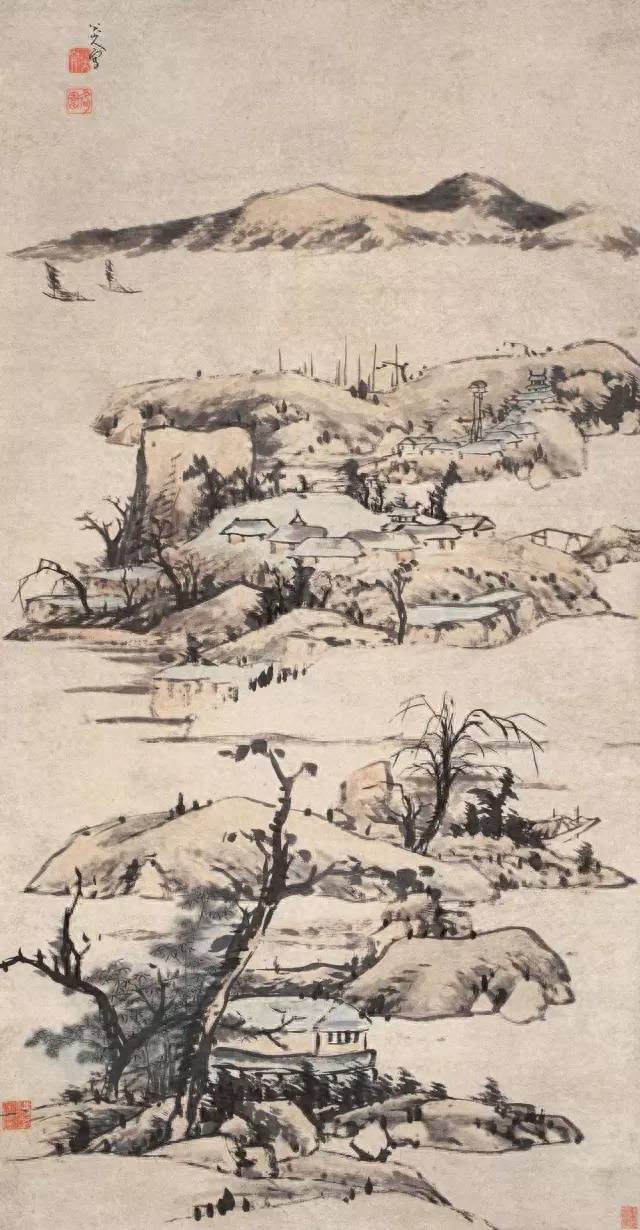
Qing Dynasty Bada Shanren imitating Ni Shanshui
Painting with calligraphy
Later generations have different opinions on the change in Bada Shanren's artistic style, and different opinions on the specific era when his calligraphy and painting styles changed. However, they all believe that the changes in his calligraphy and painting styles are closely related. If we examine the two systems of the evolution of his calligraphy and painting styles together, we will find that the two systems progress in parallel. Bada Shanren's calligraphy has three stages: absorption and exploration, breakthrough and creation, and maturity and perfection. His paintings also have the same three stages, and they are almost at the same time. The calligraphy in "Zhuanqi Sketchbook" painted at the age of 34 is mainly copied from predecessors. In "Zhuanqi Sketchbook", he painted watermelon, taro, hibiscus, chrysanthemum, banana stone, pomegranate, narcissus, cabbage, ink flower, plum blossom, exquisite Stones and ancient pines are also studies, obviously imitating Ming Dynasty painters Zhou Zhimian and Xu Wei.
Another example is his calligraphy before and after the burning of the Buddha's clothes. He pursues refreshing, thin, hard, wild and unrestrained, and suddenly exaggerates the structure of certain characters to form a sharp contrast. The paintings at this time are also characterized by exaggerated deformation and strange shapes. For example, when he painted "Ancient Plum Blossoms" at the age of 57, he was at the stage of practicing Huang Tingjian's calligraphy and exploring Kuangcao.
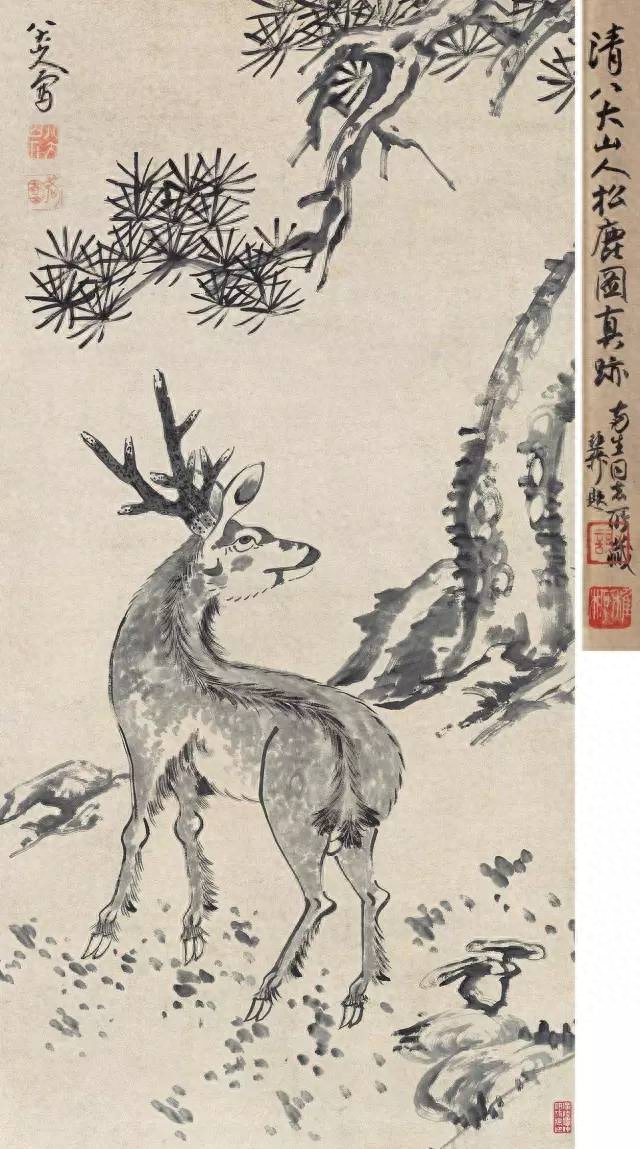
Qing Dynasty Badashanren Pine and Deer Picture
There are two flower albums handed down to the world before and after Bada returned to secular life. The "Flowers Album" before returning to secular life (collected by the Shanghai Museum) uses a thin pen, the ink is relatively light, and the composition is well-proportioned; while the flower album "Geshanrenwu Flower Album" after returning to secular life (collected by Princeton University Art Museum, USA) uses a bold and spicy brush. The contrast between the shades of ink is increased, and the composition is strange and dangerous. This is also related to the change in calligraphy style. When I painted "Flower Album" before returning to secular life, the calligraphy was still Dong style; when I painted "Ge Shanrenwu Flower Album" after returning to secular life, the calligraphy was Huang Tingjian style and wild and unruly style. Crazy grass.
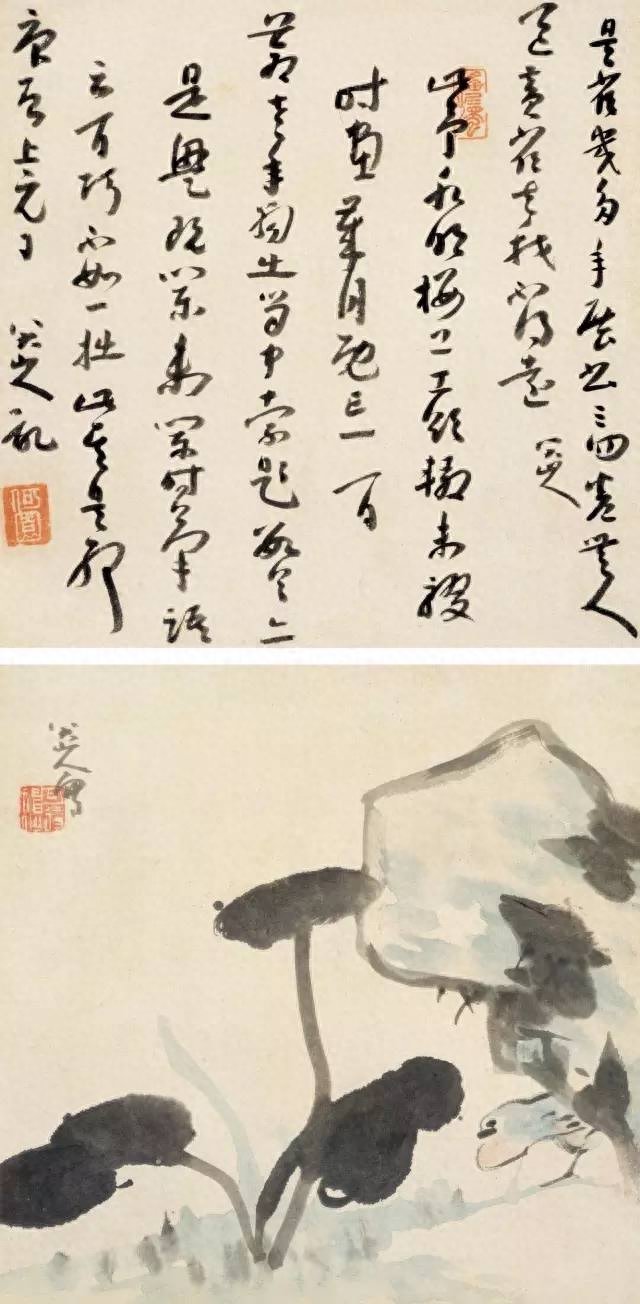
Qing Dynasty Bada Shanren Yellow Bird Picture
What clearly marks the change in his calligraphy and painting style is "Geshan Miscellaneous Painting Album" written at the age of 59 (1684). Although the painting is small, it is full of power. The calligraphy and painting themes of this work occupy half of the space. The calligraphy is in cursive style, characterized by the sudden enlargement of certain characters; the paintings are of flowers and birds, with exaggerated shapes, especially the eyes of the rabbit, which are almost square, and the round eyes are expressed in an almost square way, which proves the exaggeration of the painting method and the peculiar composition.
Changes in style are closely related to the psychological factors of the creative subject. The specific life experience of the dead king and grandson, the earth-shattering social changes, and the life trajectory of escaping into and out of Buddhism. The experiences of Badashan people are special, their experience of life is profound, and they suffer huge psychological trauma. Bada Shanren is a survivor painter, but he is not an ordinary survivor painter.
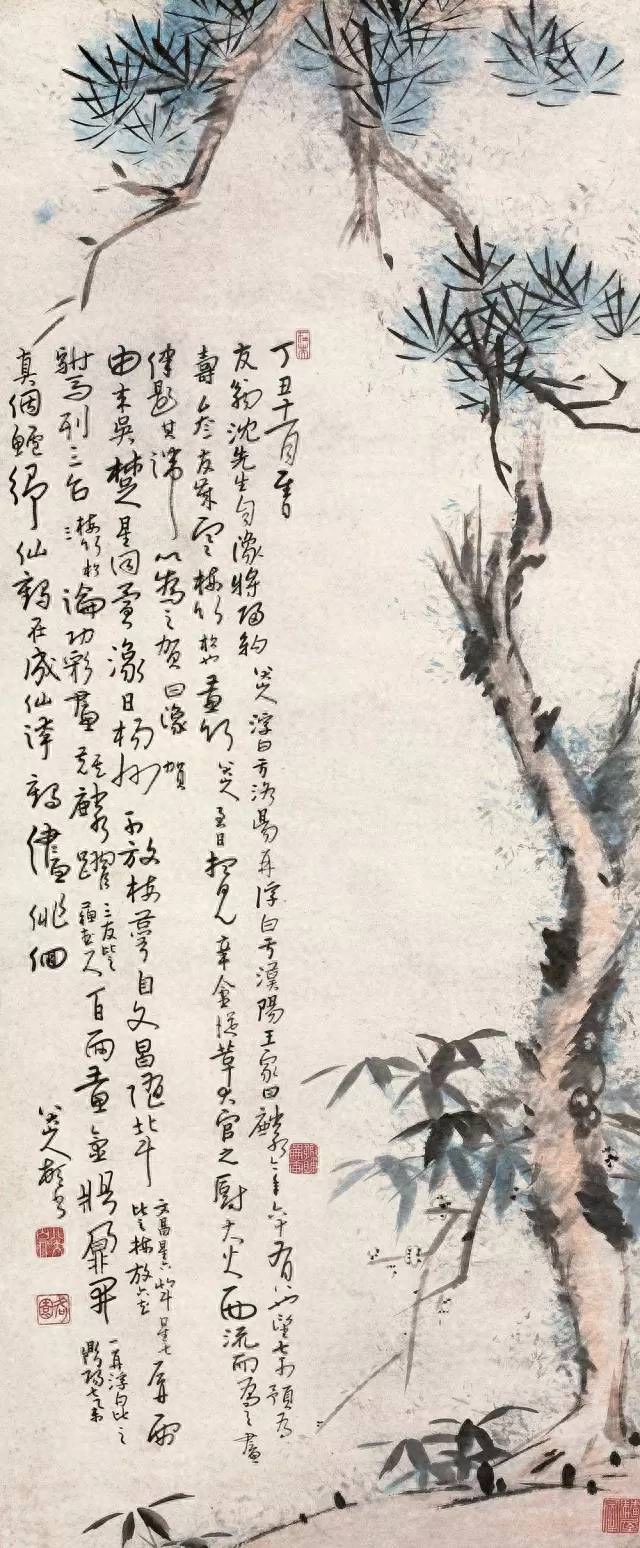
Qing Dynasty Bada Shanren, 1697, "Three Friends in the Winter"
The specialness of Bada Shanren is also reflected in the fact that he broke away from his ego in his later years, transcended the survivor complex, and became an artist identical with Dahua. The change of mentality can be seen from the change of his name: in Buddhism, he was called "Chuanqi" in order to save his life through the place of religion; when he came out of Buddhism, he called himself "Bald Donkey", laughing at himself; in his later years, he was called "Bada", the so-called "Eight Greats" refers to the "big self" of "everywhere in the four directions, I am big, but nothing is greater than me". This "big self" has integrated his life and art. His calligraphy and painting style is like that of his early years. The symmetry and balance express the inner silence; the exaggerated deformation in the second stage expresses the excitement after leaving Buddhism; and the maturity and perfection of the style in his later years are a reflection of the sublimation of his inner world.
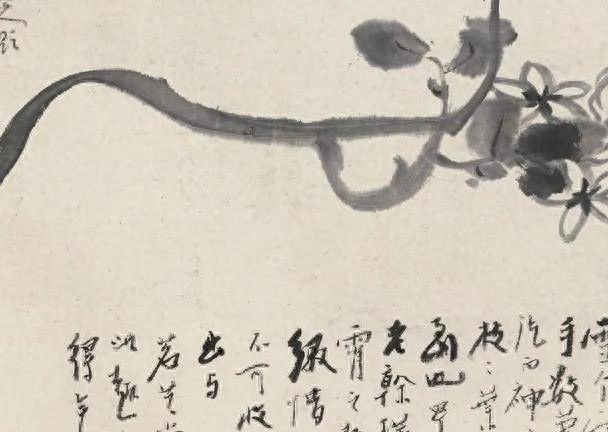
Qing Dynasty Bada Shanren Jasmine Picture
Mature calligraphy and painting have common characteristics, that is, dignified and concise, simple and natural. The so-called "eight major styles" are characterized by conciseness and implicitness, which is a kind of inner beauty. Although the calligraphy in his later years retained its original exaggerated elements, the obvious changes were that the writing style changed from complex to simple, incorporating squares into circles, weakening the pauses, and reducing the number of strokes, thus reaching a state where people and calligraphy are both old and natural. The same is true for painting. Although the paintings of Bada Shanren in the early and middle period have reached the characteristics of ancient shapes and open layouts, from the perspective of pen and ink, they are a bit spontaneous and lack of conciseness. After reaching the age of 70, he has reached the point where he can express the richest connotation with the most concise pen and ink. Just as calligraphy after the age of 70 integrates the square into the circle, the paintings after the age of 70 eliminate all corners and are concise and subtle. For example, the painting and calligraphy of the 72-year-old "Flowers on the River" have reached a state of solemnity, refinement, clarity, forcefulness, subtlety, and emptiness.
Using calligraphy into painting is not Bada Shanren’s original creation. Because calligraphy and painting use the same brushes and the historical fact that calligraphy matured earlier than painting, painters before Bada Shanren began to apply calligraphy to painting, and ancient Chinese painting theory also drew heavily on calligraphy. Although not original, Bada Shanren is a leader in using calligraphy into painting. For three hundred years, Bada Shanren has been famous as a painter, but people often overlook that his painting achievements are based on his profound skills in calligraphy. In a sense, without the "eight major styles" of calligraphy, there would be no unique style of "eight major paintings". Bada Shanren, who is proficient in calligraphy and painting, attaches great importance to the intrinsic connection between calligraphy and painting. He not only infiltrates calligraphy brushes and font spatial shapes into painting in creative practice, but also clearly puts forward the proposition of "painting and calligraphy" in theory.
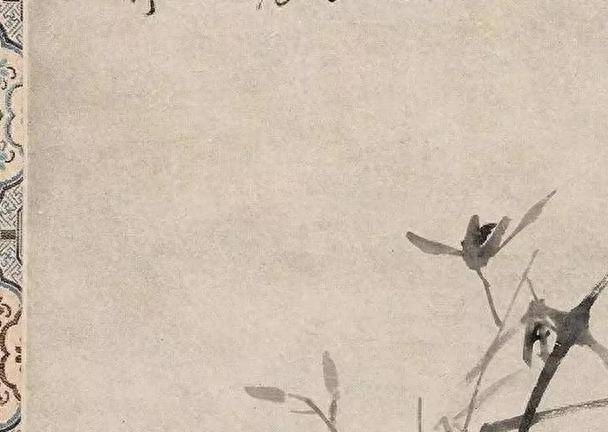
Bada Shanren, 1686, Zhilan Qing Dynasty, vertical scroll, ink on paper, sold for 12.52 million yuan
As the researchers pointed out, Bada Shanren used the central strokes of seal script in regular cursive script, which avoided the shortcomings of the "middle timidity" that regular script has used since the Tang Dynasty to emphasize the rising and closing ends while being weak in the middle, and explored a line that coincides with the Jin Dynasty. The human brushwork method is also suitable for the cursive brush strokes. This is done within the calligraphy system. As a painter, Bada Shanren is not limited to combining within the calligraphy system, but applies his understanding of the calligraphy system to the painting system.
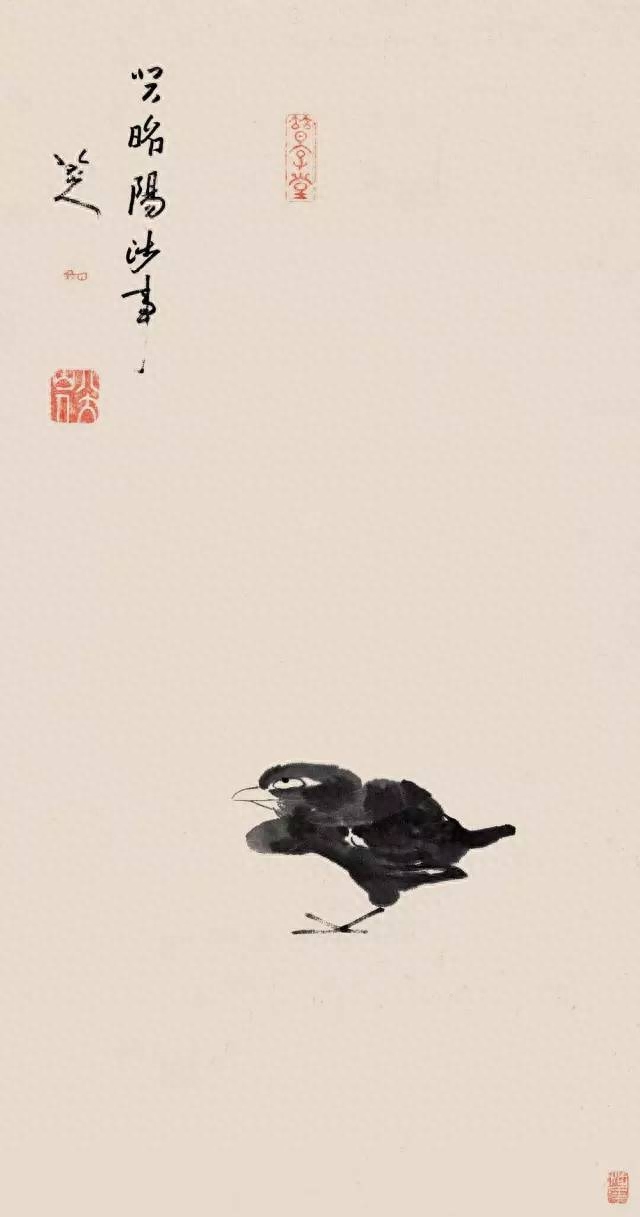
Qing Dynasty Badashanren Lone Bird Picture
Bada Shanren's approach of incorporating calligraphy into painting is not simply to add calligraphy and painting together, nor to turn paintings into purely abstract symbols, but to infiltrate calligraphy language elements into paintings to enrich the language of painting. Although calligraphy and painting are both visual arts and contain elements of imagery, they belong to two separate systems. Calligraphy uses abstract text symbols as the medium of expression, while painting must "correspond to the pictogram of objects."
Bada Shanren not only knows that "calligraphy and painting are different and cannot be confused", but also realize that painting can be combined with calligraphy. In their creative practice, they incorporate the brushwork and spatial composition of calligraphy into painting. Bada Shanren's use of calligraphy and painting was mainly reflected in his later years. In his early learning stage, although both calligraphy and painting reached a very high level, the two systems were not closely connected and still worked independently. After about the age of 60, the signs of incorporating calligraphy into painting became increasingly prominent. His use of calligraphy in painting is reflected in two aspects: first, he uses calligraphy's rich and restrained center strokes in painting, and second, he uses calligraphy's abstract space composition to deal with the shape and whiteness of the picture. In his later years, Bada Shanren's paintings became clearer and richer, which was due to the subtle and powerful brushwork of seal script being integrated into his paintings.
The 64-year-old work "Fish and Duck Picture Scroll" tends to have rounded brush strokes, the 65-year-old "Lotus Pond Playing Birds Picture Scroll" is "arc-shaped", using the center to represent the stone wall, and the 66-year-old "Birds and Stone Picture Album" has thick brush strokes. It can be seen that the works of the 69-year-old have a seal script style. When he was 72 years old, the "Flowers on the River" is even more of a seal script style. The lotus stem is written directly with a smooth seal script style. In his later years, Bada Shanren liked to paint landscapes, and he mostly used a center-point pen. He painted more outlining than scratching, and the trees and rocks were round and thick. As mentioned before, the shape of Bada Shanren is extremely exaggerated and deformed. The rocks are painted with large tops and small bottoms, birds are painted with bulging bellies and necks, and tree trunks are painted with thick tops and thin bottoms, giving people a sense of "weightlessness" of precarious standing. The steady and rounded center pen relieves the pressure of "weightlessness" to a certain extent. The combination of ancient shapes and steady brushwork not only has a strong visual impact, but also withstands repeated playback.
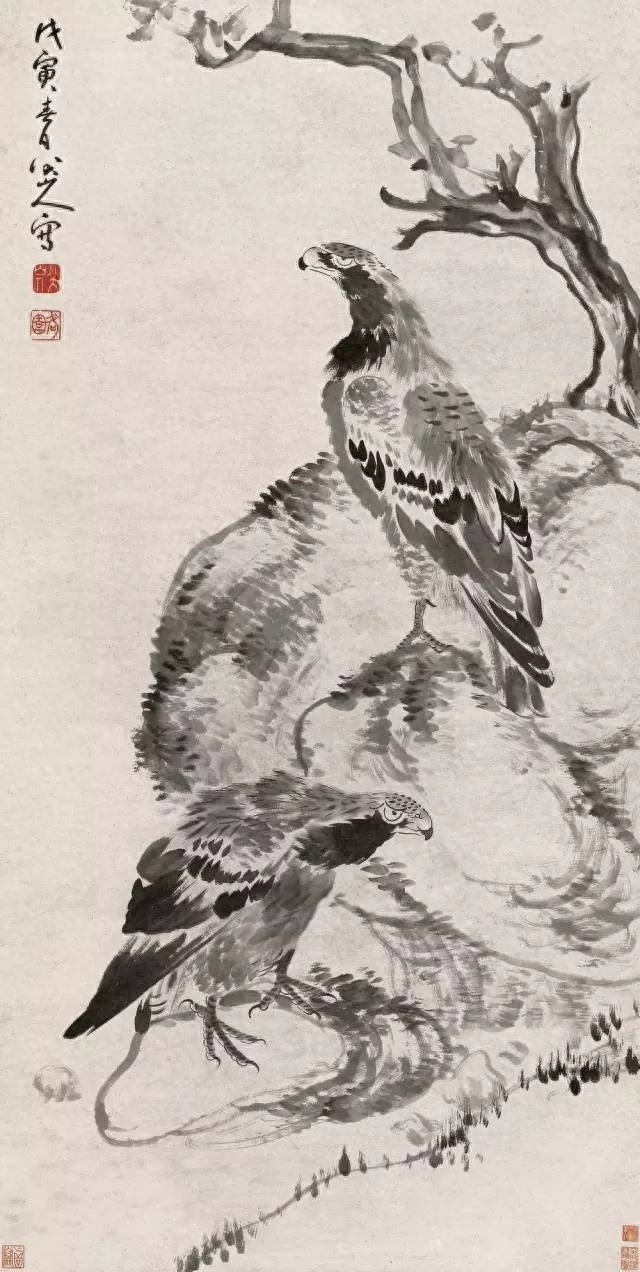
Qing Dynasty Bada Shanren, 1698, Panasonic Double Eagle
The strange and ancient shapes of Bada Shanren's paintings can also be seen to have many similarities with the spatial structure of his calligraphy. The stone is large at the top and small at the bottom, the bird's belly is bulging and necked, the back is arched and one leg is exposed, and the weightless shapes of the tree trunks are thick at the top and thin at the bottom. All these weightless shapes can be traced back to the spatial structure of the calligraphy structure. From his calligraphy works, the cursive five-character couplet "Collecting herbs and encountering three islands, seeking truth and encountering nine immortals" and the word "Good Night" in "Good Night Book" and "Involved Things" often written in his later years can be seen. When Bada Shanren arranges the font space, they often make it larger at the top and smaller at the bottom, or wide in the middle and narrowed at the top and bottom. Bada Shanren, who understood the principle of "painting combined with calligraphy", transformed these abstract spatial structures in calligraphy into the shapes of paintings, forming a personality that is different from his predecessors. Observing further, the graphics in the composition of Bada Shanren's paintings often point to the upper right, with small arcs connecting two basically symmetrical arcs. In fact, in his calligraphy structures, there are also two arcs enclosed, Point to the fusiform space on the upper right. In the author's opinion, this is also an aspect of Badashan people's use of calligraphy in painting and the application of calligraphy graphics in painting.
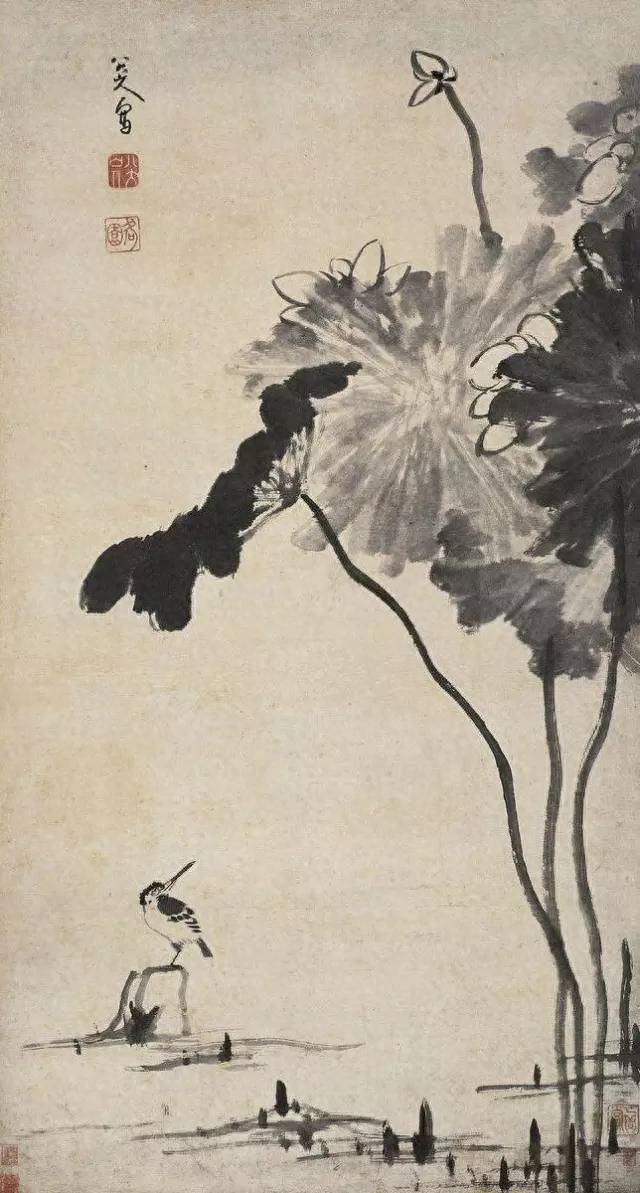
Qing Dynasty Bada Shanren Lotus and Kingfisher
Painting into book
Applying calligraphy to painting means painting absorbs nutrients from calligraphy, and using painting to incorporate calligraphy means calligraphy absorbs nutrients from painting. The former gave Bada's paintings a unique style, and the latter gave Bada Shanren's calligraphy its own look. In comparison, Bada Shanren's achievements in incorporating paintings into books are more significant, and his significance in the history of art is even greater. Because before the Eighth Congress, the brushwork used in calligraphy had always influenced painting. It was only at Bada Shanren that the composition of painting truly affected calligraphy.
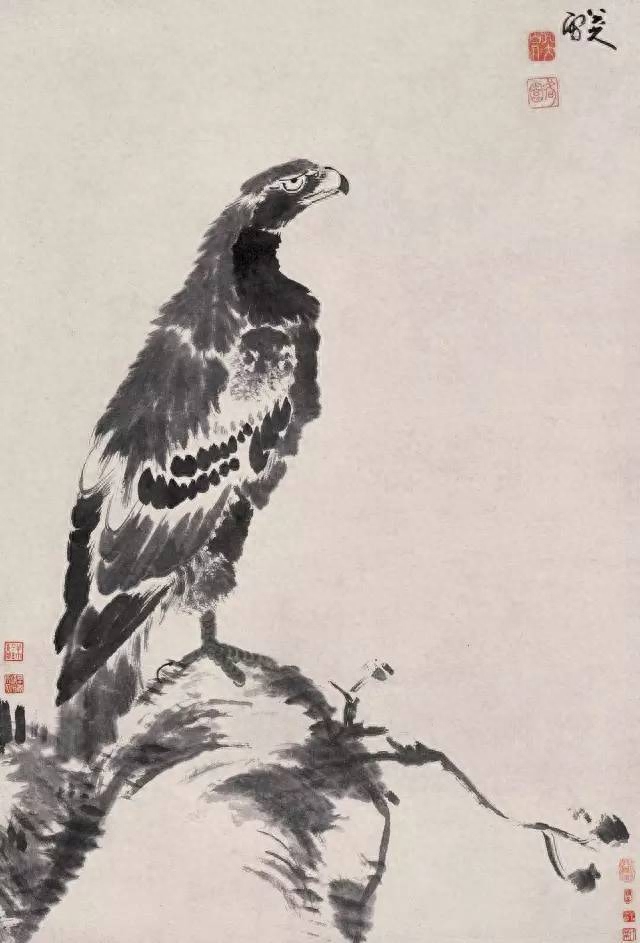
Qing Dynasty Badashanren independent look
In theory, Bada Shanren not only proposed "painting combined with calligraphy", but more importantly, based on his own experience, he proposed the proposition of "calligraphy combined with painting". He said in the eight titles of "Calligraphy and Landscape Album": "The painting method is Dong Beiyuan, and a section of Lin Beihai's calligraphy is written at the back to show the calligraphy and painting method." "Calligraphy and painting method" means painting is incorporated into the book. If we talk about "painting and calligraphy", predecessors have had similar opinions. For example, Zhao Meng of the Yuan Dynasty wrote in the postscript of "The Picture of Beautiful Rocks and Sparse Forests": "Stones are like flying white trees, and the writing of bamboo is still based on the 'Eight Methods'" . If someone can understand this, then they will know that calligraphy and painting are originally the same." What we are talking about is using calligraphy into painting.
The proposition of "calligraphy and painting" was first proposed by Bada Shanren. Bada Shanren is different from Shi Tao. Shi Tao has specialized theoretical works. Although Bada Shanren does not have special theoretical works, his idea of incorporating paintings into books is an outstanding theoretical contribution. Bada Shanren's ideas inspired future generations that not only can the brushwork of calligraphy be used in freehand painting, but also conversely, the image modeling and brushwork elements of freehand painting can penetrate into the calligraphy system. This idea plays an important role in the formation and development of painter's calligraphy in the true sense.
Although Chinese calligraphy and its theory matured early, in the later period, its development momentum was not as good as that of painting and its theory. When freehand painting began to take shape, it did draw lessons from the brushwork of calligraphy. However, after the development of the Song, Yuan and Ming dynasties, the brushwork and shapes of freehand painting became more and more rich and mature, especially the thick, light, dry, wet and green ink techniques. It has unique aesthetic taste. Xu Wei and Dong Qichang in the Ming Dynasty had absorbed the nutrients of freehand brushwork and ink painting in the practice of calligraphy creation. By Bada Shanren, they clearly proposed "painting and calligraphy" in theory, and took a big step forward in creative practice. .
Bada Shanren's use of paintings in books is mainly reflected in the maturity period of his later years, which can be divided into two aspects: spiritual level and technical level. On the spiritual level, we pursue the meaning of painting to connect with the meaning of calligraphy, and infiltrate the spirit and mood of freehand painting into calligraphy. As Bada Shanren grew older, he produced more calligraphy works. In the last year of his life, the number of calligraphy works exceeded that of paintings. As pointed out earlier, the so-called "imitation" and "imitation" of Bada Shanren's calligraphy in his later years were actually expressing his own ideas through the content of other people's writing, and expressing the interest of painting through writing.
After experiencing too much bitterness in life and gradually transcending the ego-consciousness of the survivors, in his later years Bada Shanren was neither bound by Buddhism nor saw through the world of mortals. Only the kingdom of art was his ideal place of sustenance. Bada Shanren's freehand paintings in his later years have both a "vaguely cynical" sense of humor and a return to nature's vitality and childlike interest. He consciously integrated the humor, vitality and childishness of painting into the lines of calligraphy, making his calligraphy bright, lovely, humorous and interesting. In his later years, he experimented with using paintings as books, or calligraphy was another form of expressing his freehand paintings. Bada Shanren wrote a lot of regular script in his later years, and he still wrote small regular script at the age of 80. In his later years, the small regular script was like a painting. He was not impatient and impatient. He started writing slowly, and followed the movement of his wrist, allowing him to form whatever he wanted. Painting was integrated into the structure of the characters. image modeling.
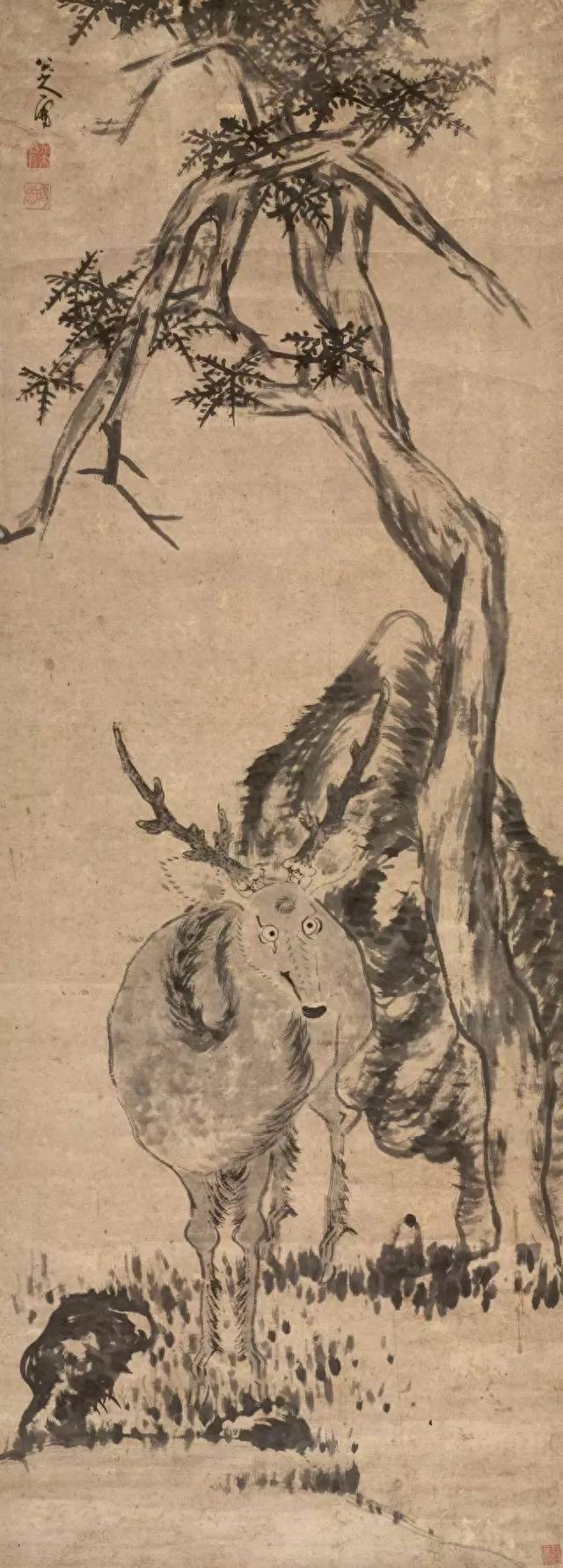
Qing Dynasty Badashanren Bailu Picture
At the technical level, Bada Shanren is good at incorporating the characteristics of freehand brushwork and spatial graphics into calligraphy. He has been immersed in the black and white world of pen and ink all his life. His paintings rarely use color and mainly rely on dripping pen and ink to speak. Judging from his poems and letters with friends, Bada Shanren's emotional world is detailed and rich. Compared with the previous Xu Wei, although both of them had "crazy" experiences, Ba Da's "crazy" was measured and he just cried, laughed and danced by himself. He did not hurt his friends or cause pain to others. Among the two, Bada Shanren is more particular and meticulous in the handling of pen and ink and composition. Although Bada Shanren's freehand paintings have strange and ancient shapes, they have never been divorced from concrete images. His paintings are harmonious in the relationship between concreteness and abstraction, and are both broad and subtle.
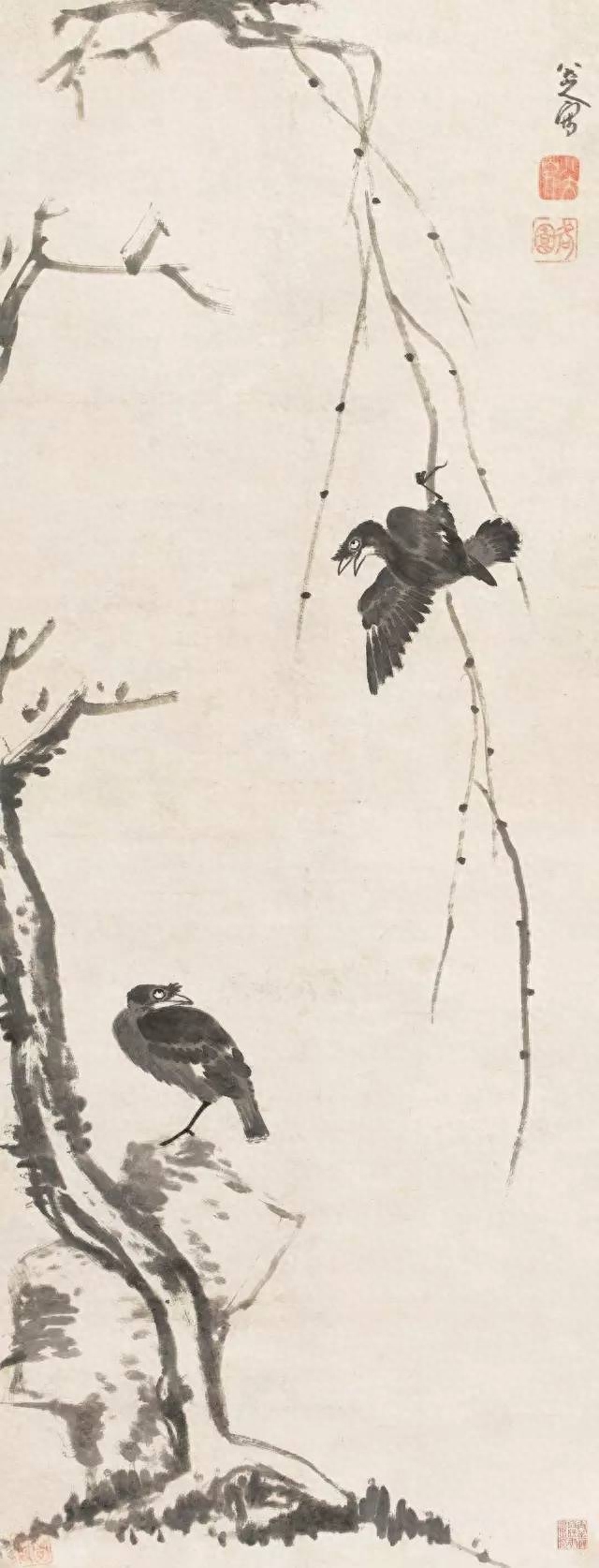
Qing Dynasty Bada Shanren Willow Myna
Bada Shanren never believed in painting with brushes. As he got older, he used concise and exquisite brushwork to create unique images. These inherent qualities in painting have a subtle influence on calligraphy, making his calligraphy skills reach the level of perfection. He wrote in a poem: "The sword is a skill, and the knife is like a pen. The Chu-Han water is blunt and weak, but the Guang-Han water is sharp and sharp. Why should it be mixed with the Fujian River? Yuan Gong is a sword. It is clear that the water is a stroke, so this Eight Sheng Yi. In the past, Ruan Shenjie secretly solved Xun Jibei. Since Yale was used as a weapon, he pushed the energy and strength. Yuan Gong was originally weak, and the copper and iron broke the empty corridor."
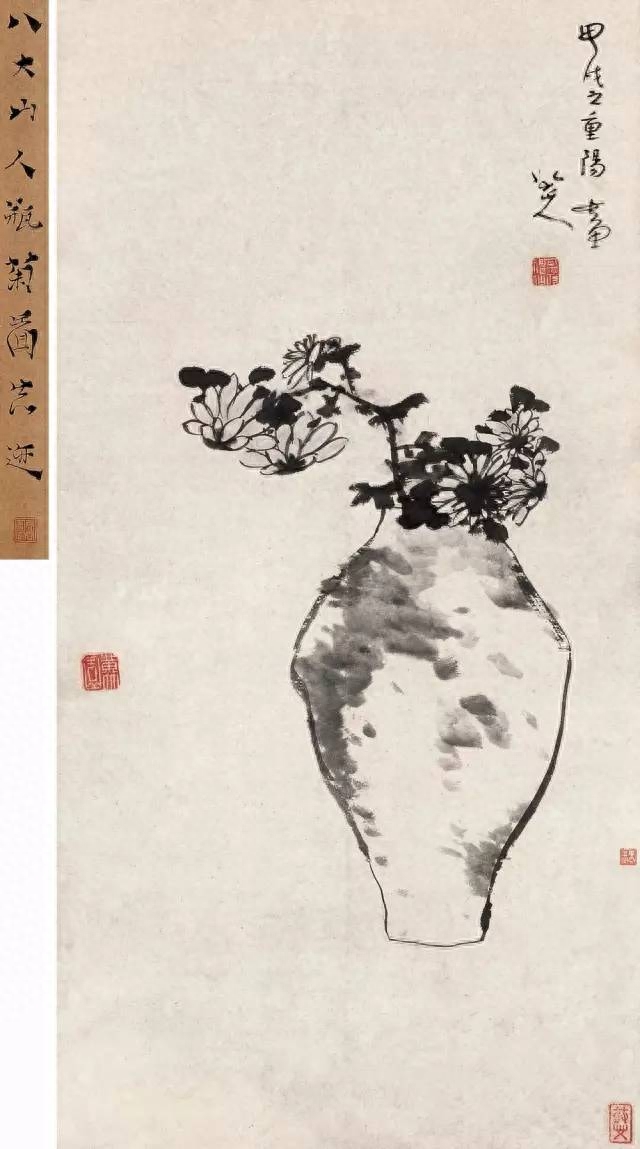
Qing Dynasty Bada Shanren, 1694, Vase of Chrysanthemums
The poem cites two historical allusions: First, during the Three Kingdoms period, Pu Yuan forged Zhuge Liang's sword. He was familiar with the water quenching of the Shu River so that he could create a "magic sword" for cutting copper and iron. Therefore, with his exquisite skills, he could distinguish the water of the Shu River. Eight liters of Fujiang water was mixed into it; secondly, Ruan Xian listened to the music and could tell that the instruments made by the royal music officials were one millet shorter than the standard of the Zhou Dynasty jade ruler. He used these two allusions to explain the subtle differences in painting brushes, and pointed out that the use of energy and force must be done properly. Although Pu Yuan is powerless, he can cut copper and iron with his sword. The key is that he has a "magic sword" in his hand and is very skilled at it. Bada Shanren requires himself to be as good as Pu Yuan in making knives and Ruan Xian in interpreting laws, and he also incorporates the fine brushwork and ink in painting into calligraphy. It should also be pointed out that Bada Shanren's calligraphy became more concise in his later years, and conciseness is a high degree of purification. If you look closely, there are subtle changes in the length and straightness of the strokes, reaching a level of simplicity and richness. If this is the "skill of the pen", then the "wonderfulness of the ink" is reflected in the changes in the shades of green and moist. For example, in "Linhe Collection" written by the 74-year-old, the shades of ink follow the pen, and the green and moist colors are written in light ink. The changes clearly draw on the ink method of freehand painting.
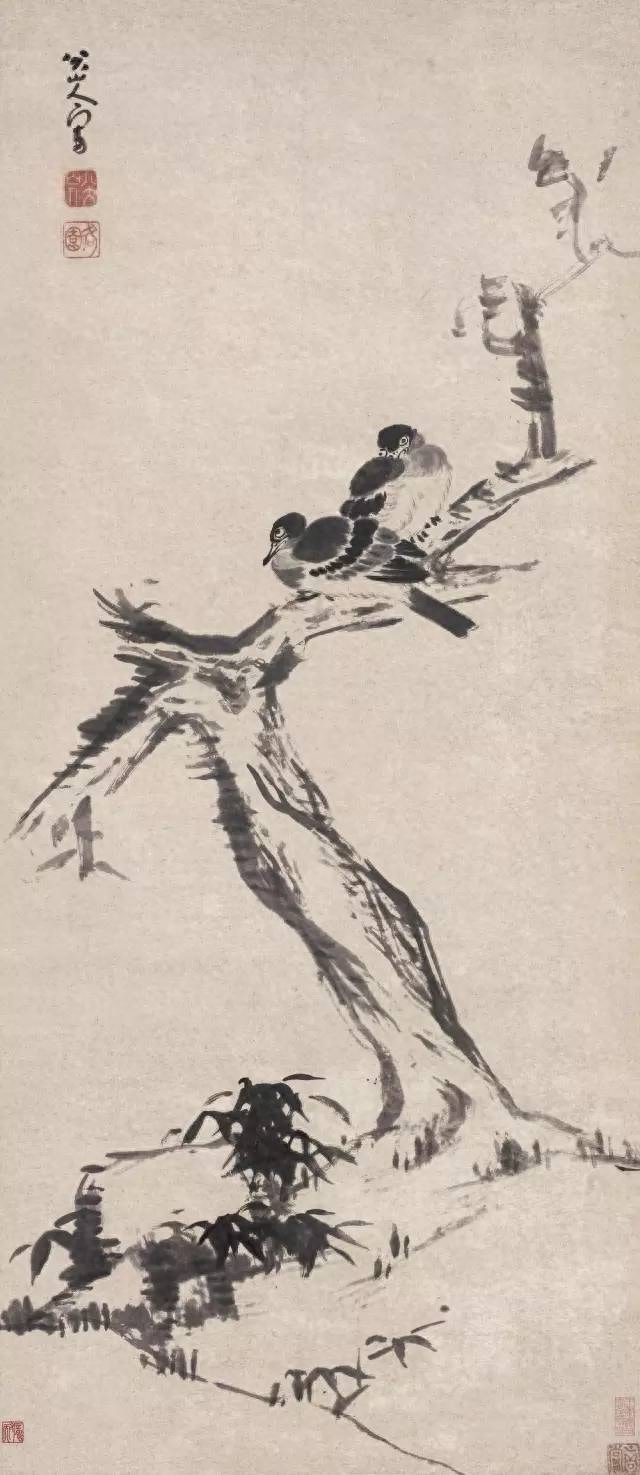
Qing Dynasty Bada Shanren Two Birds on Ancient Wood
Just as the brushwork of seal script is integrated into freehand painting, Badashanren, in turn, applies the round, strong and elastic brushwork of painting lotus stems to cursive script, such as the character "蛛" in the "Five Jue Poems in Running Script" written by around 71 years old. Long and vertical, the 72-year-old "Flowers on the River" painting depicts the "lang" and "slant" in the poem, just like writing a lotus stem, which is very three-dimensional. This kind of attempt is unprecedented and is the finishing touch of the "Eight Elements".
The single glyphs of Bada Shanren calligraphy are often divided into large spaces at the top and small spaces at the bottom, such as the "shi" in the word "sheshi". This feature can be traced back to the large and small structure at the top and bottom of the painted stone. Intentionally compressing or enlarging the space of a certain character in the compositional layout is also affected by its painting space schema. Bada Shanren used his unique spatial pattern in painting to influence calligraphy, making his calligraphy break through the shackles of inherent tradition. By the early Qing Dynasty, ancient calligraphy had developed into various fixed patterns. The early Qing Dynasty was still a period when Tie Xue was popular. Due to various reasons, Tie Xue had become rigid.
Bada Shanren, who is very individual and innovative, is unwilling to follow the footsteps of his predecessors and adopts a "both-and" approach to innovation. Within the calligraphy system, he "combined" ancient calligraphy into one, as he said in the inscription of "Linhe Xu": "The calligraphy of the Jin people is far-reaching, the calligraphy of the Song people is fast, and the calligraphy of the Tang people is smooth. It is a combination of both." The Qingyuan charm of Jin people's calligraphy, the unfettered personality of Song people's calligraphy, and the subtlety of Tang people's calligraphy all combine to form their own appearance. What is even more valuable is that he combines "calligraphy" and "painting" to connect the two systems. He selects certain elements from the unique painting imagery he created and applies them to calligraphy, creating a new era of calligraphy for painters. It was the first time that seal script was introduced into cursive script.
In short, Bada Shanren's calligraphy style and painting style are formed through mutual influence and mutual penetration. The mutual "combination" of writing into painting and painting into writing has enabled Bada Shanren to achieve outstanding achievements in both calligraphy and painting. "Calligraphy and painting have two ends, and their functions are integrated" (Shi Tao's words). Standing in the middle, Bada Shanren grasped the two ends tightly and opened the road of mutual communication, making both calligraphy and painting at the forefront. At the forefront of the times.
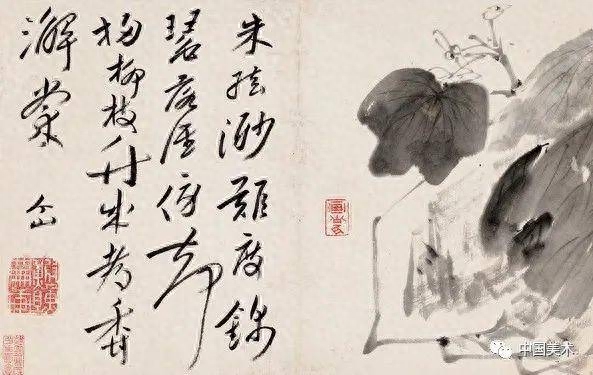
One of Geshan miscellaneous picture albums
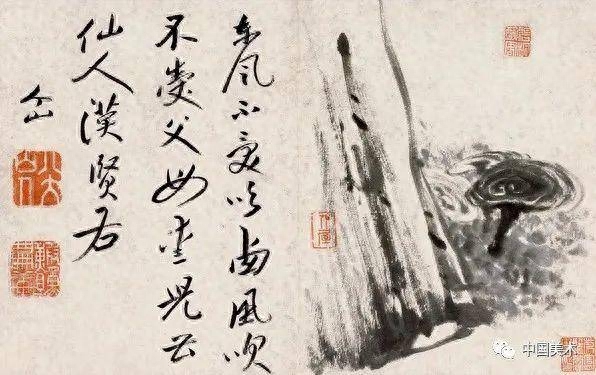
One of Geshan miscellaneous picture albums
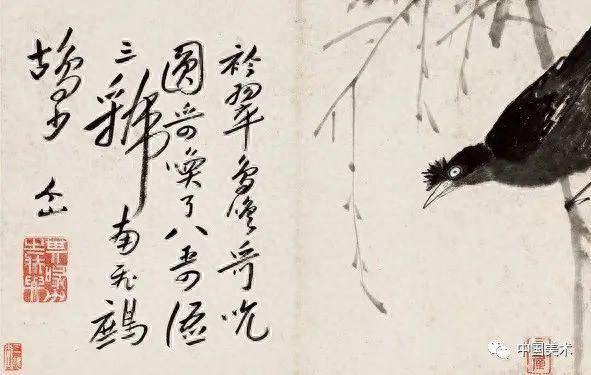
One of Geshan miscellaneous picture albums
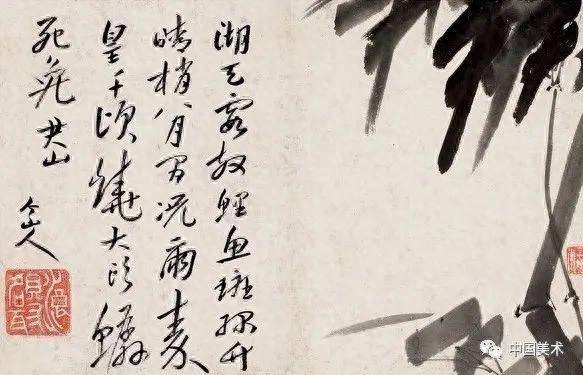
One of Geshan miscellaneous picture albums
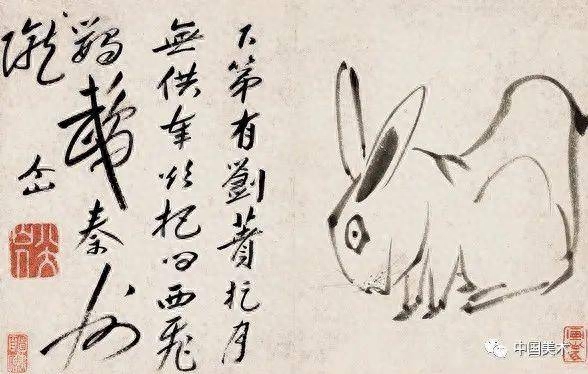

One of Geshan miscellaneous picture albums
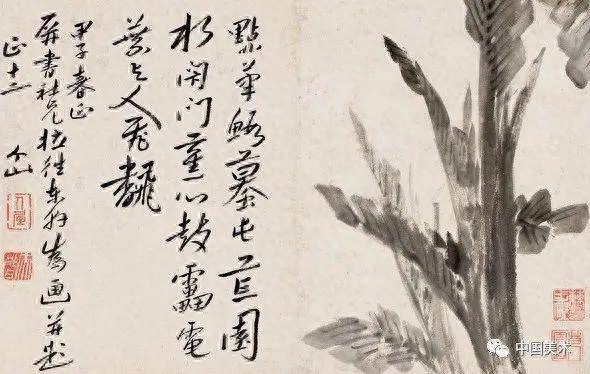
One of Geshan miscellaneous picture albums

Zhu Da's running script excerpt "Mianshui Yan Tan Lu"

Zhu Da's running script Li Bai's poems
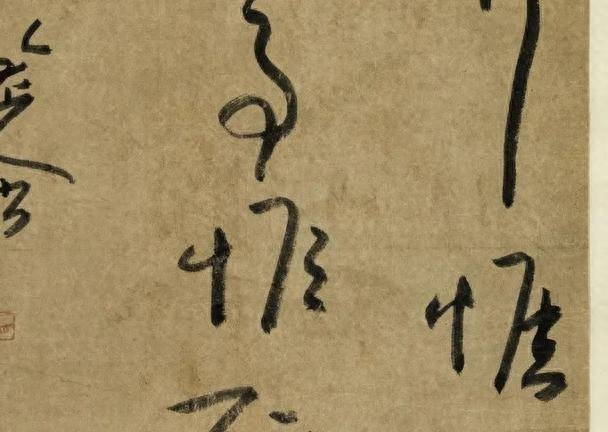
Zhu Da's Cursive Script "Book of Changes" Sentences
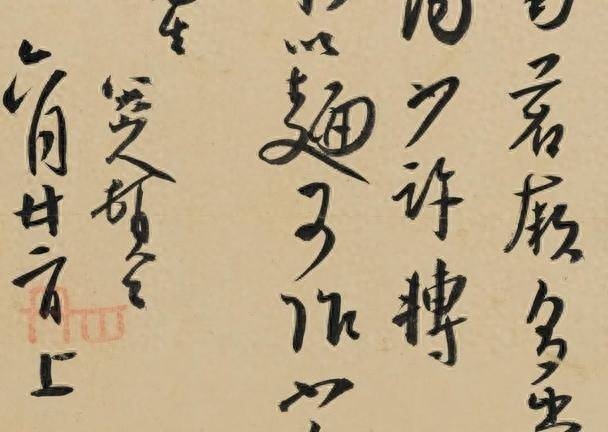
Zhu Da’s letter to Mr. Lucun
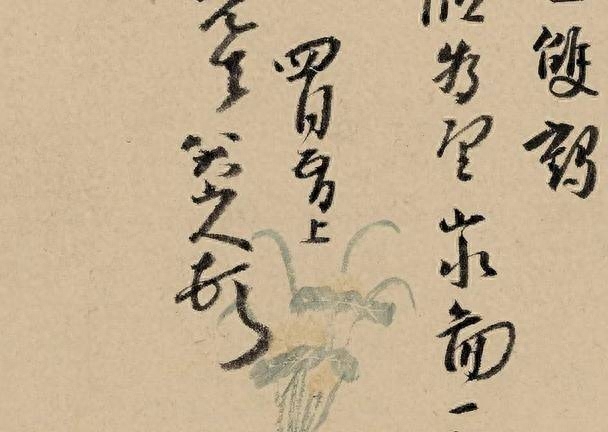
Zhu Da’s letter to Mr. Lucun
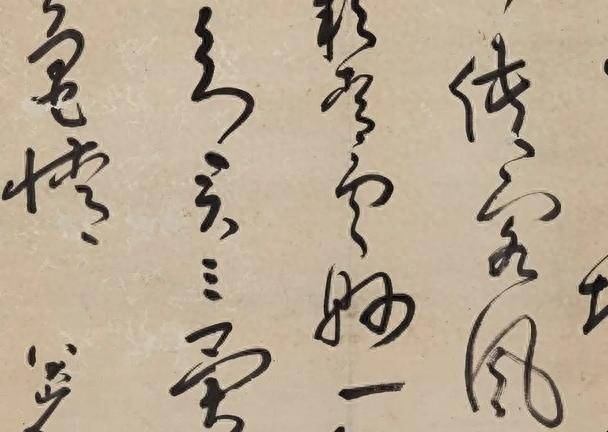
Zhu Da's seven-character poem in cursive script
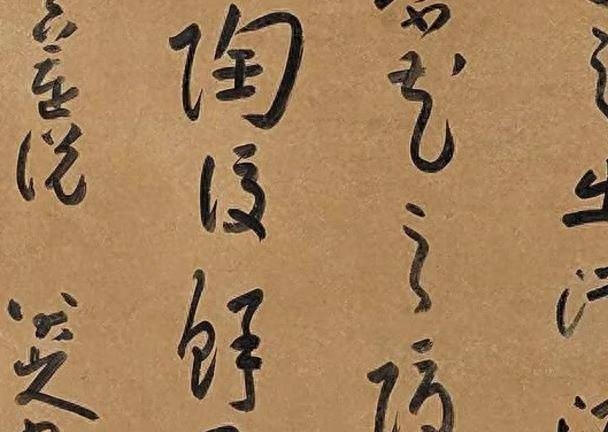
Zhu Da's cursive script "Shuo Ai Lian"
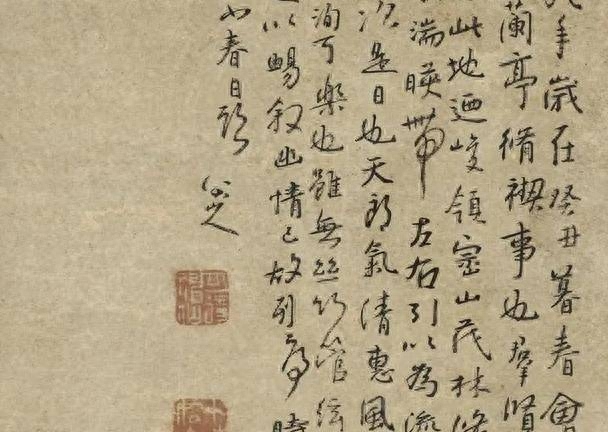
Zhu Da's running script "Preface to Orchid Pavilion"
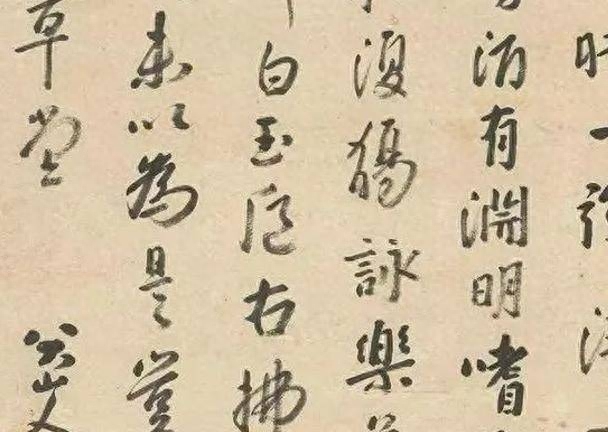
Qing Dynasty, Bada Shanren, Poems of Three Friends of Shu Beizhuo, vertical scroll, ink and color on paper, sold for 22.61 million yuan
Articles are uploaded by users and are for non-commercial browsing only. Posted by: Lomu, please indicate the source: https://www.daogebangong.com/en/articles/detail/jian-shang-ba-da-shan-ren-shu-hua-shuang-xiu.html

 支付宝扫一扫
支付宝扫一扫 
评论列表(196条)
测试